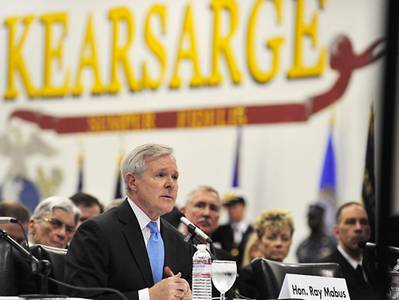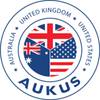USS Kearsarge Hosts Senate Field Hearing on Energy
Norfolk, Va. - Amphibious assault ship USS Kearsarge (LHD 3) hosted a Senate subcommittee field hearing on energy March 12, the first time since 1960 that a Senate hearing was held aboard a Navy vessel.
Senator Jeanne Shaheen, chair of the Senate Subcommittee on Water and Power, was joined by Senator Mark Warner from Virginia. Among those who addressed the two Senators were Secretary of the Navy Ray Mabus and Former Secretary of the Navy and retired Senator John Warner. Both testified about the Navy's current strategy to reduce energy consumption and decrease its reliance on foreign oil.
Mabus' testimony focused on how changing the way the Department of the Navy obtains and uses energy makes better war fighters and increases the military's energy security.
Mabus spoke about how reliance on foreign oil presents strategic vulnerabilities.
"We would never depend on many our foreign oil suppliers to build our ships or our aircraft, or our ground equipment, but we give them a say in whether those ships sail, whether those aircraft fly, or whether those vehicles run, because we depend on them for fuel," stated Mabus.
Supply shocks are also a strategic vulnerability.
"For every dollar charged for a barrel of oil, the Department of the Navy spends $30 million," Mabus said. "When unrest in some oil-producing regions broke out last year, the price of a barrel increased by $30, which increased the Navy's fuel bill by over $1 billion. That additional $1 billion in fuel costs we could not have planned for left us having to take money out of operations, meaning our sailors and marines steamed less, flew less and trained less."
Mabus described several initiatives designed to lessen dependence on foreign oil, including encouraging private development of a domestically-produced drop-in biofuel, which can be used to power the Navy's ships and planes.
When asked why the Navy is focused on energy security, Mabus explained, "We can't afford not to. We cannot afford to wait until price shocks or supply shocks leave us no alternative. We cannot afford to wait while other nations race ahead of us on energy reform. If we do not have, or cannot afford, the energy to power our platforms, the platforms themselves may be of little value. And if we develop a domestic fuel source less vulnerable to price shocks, we will be able to afford more of the ships and planes we need."
Mabus set five aggressive goals for the Navy and Marine Corps to increase energy efficiency and use of alternative energy:
• By 2020, at least 50 percent of total Department of Navy energy will come from alternative energy resources.
• By 2020, the Department of Navy will produce at least 50 percent of shore-based energy requirements from alternative resources, and 50 percent of Department installations will be net-zero.
• The Department of Navy will demonstrate a Green Strike Group in local operations by 2012 and sail the Great Green Fleet by 2016.
• By 2015, the Department of Navy will reduce petroleum use in non-tactical vehicles by 50 percent.
• Evaluation of energy factors will be used when awarding contracts for systems and buildings.
Shaheen, who also sits on the Senate Armed Services Committee, lauded Mabus' efforts to lead the Navy toward more energy efficient technologies and alternative energy sources, including biofuels.
"When our military improves the way it uses energy, it gives us a strategic advantage and strengthens our national security," Shaheen said. "The less beholden our troops are to fuel supply lines, the less vulnerable they are in the field. The more efficient their battery packs are, the more time they have to complete the mission. The Navy has set the pace for improvements in energy use. Now it's time for the rest of the nation to follow."
Kearsarge, one of eight amphibious assault ships in the Navy, recently installed stern flaps in an effort to cut energy costs, and USS Makin Island (LHD 8) is the first amphibious assault ship to engage a hybrid engine system, which allows it to run off self-generated electrical power while steaming at low speeds.
"Just on Kearsarge, their stern flaps saved the Navy about $2 million its first year," Mabus said.











